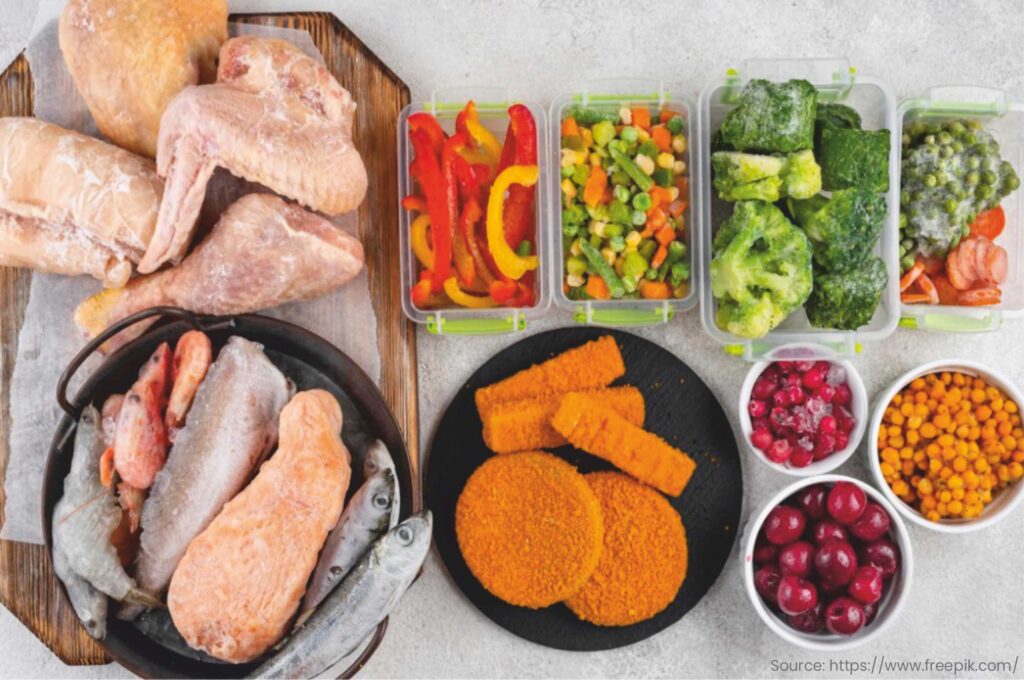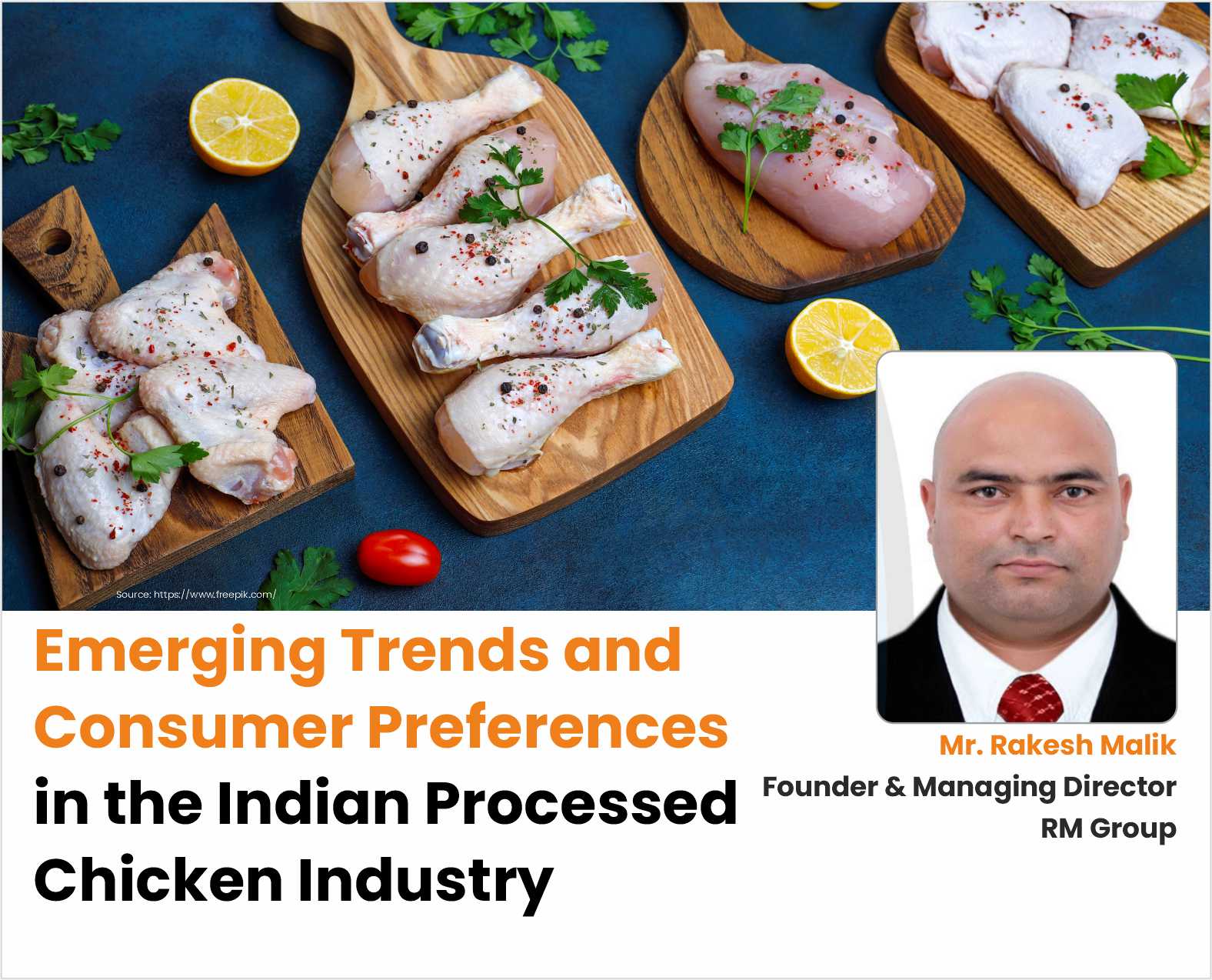Emerging Trends and Consumer Preferences in the Indian Processed Chicken Industry

Mr. Rakesh Malik
Founder & Managing Director
RM Group
Introduction
India, a land of diverse cultures and tastes, has seen a significant transformation in its culinary landscape over the years. One of the most notable shifts has been the increasing popularity of processed chicken and value-added chicken products. The Indian poultry industry has experienced remarkable growth, driven by factors such as a Growing Population, rapid urbanization, and changing consumer preferences. This surge in demand for processed chicken signifies more than just a change in dietary choices; it reflects a broader societal shift towards convenience, health consciousness, and culinary exploration.

In this article, we delve into the factors propelling the rising demand for processed chicken and value-added chicken products in the Indian market. From the fast-paced urban lifestyle that craves convenience to the growing awareness about health and nutrition, we explore the intricacies of this trend. Additionally, we delve into the innovative culinary landscape of India, where diverse tastes and flavors are met by a wide range of processed chicken products. Furthermore, we discuss the critical aspects of food safety and quality assurance that have contributed to the burgeoning trust of consumers in these products.
The changing demographics of India, marked by an increase in working professionals and dual-income families, have further accelerated the demand for quick and easy meal solutions. Coupled with developments in the supply chain, which have made these products accessible even in the remotest corners of the country, processed chicken has become an integral part of the Indian household’s culinary repertoire.
In the following sections, we will explore in detail how these factors have coalesced to make processed chicken and value-added chicken products a staple in Indian households, shaping not just the way people eat but also the way they perceive convenience, health, and culinary delight.
Changing Lifestyles and Convenience
The modern Indian lifestyle is characterized by the hustle and bustle of urban living. With both partners often working or all members of family working, there’s a growing need for quick and convenient meal options. Processed chicken products fit the bill perfectly. Whether it’s chicken nuggets for a speedy snack, sausages for a hearty breakfast, pre-marinated cuts for a hassle-free dinner, or ready-to-eat chicken dishes for a quick and satisfying meal, these products offer a straightforward way to include poultry in daily meals. This convenience factor has made processed chicken and ready-to-eat chicken products a go-to choose for busy households, particularly in densely populated urban areas.
Growing Health Consciousness
In recent years, India has seen a significant rise in health consciousness among consumers. Processed chicken and ready-to-eat chicken products are perceived as healthier alternatives to traditional chicken preparations due to several key factors. First, these products are subject to standardized processing, meaning they go through rigorous quality control checks, reducing the risk of contamination or unsafe handling. Second, they often come with clear and informative labels detailing their nutritional content. This transparency helps consumers make informed dietary choices. Moreover, many manufacturers are responding to the health trend by offering low-fat and low-sodium options, appealing to those who are closely monitoring their dietary intake. This emphasis on health and nutrition is a significant driver of the increasing demand for processed chicken and ready-to-eat chicken products among health-conscious individuals.
Varied Tastes and Culinary Innovation
India’s culinary landscape is rich, diverse, and vibrant. With a wide range of regional tastes and preferences, Indian consumers are increasingly looking for variety and exciting flavors. This demand for diversity is met by value-added chicken products, including marinated cuts and ready-to-eat options. These products offer a multitude of flavors and cuisines, from tandoori-style chicken to spicy southern fried chicken, and they are often ready to eat, providing a convenient solution for those seeking quick yet delicious meals. The convenience of ready-to-eat chicken products combined with the constant culinary innovation in the sector makes them highly appealing to Indian consumers, who love experimenting with different tastes and dishes.
Food Safety and Quality Assurance
Food safety and hygiene are paramount concerns for consumers in India. The processed chicken industry and the ready-to-eat chicken sector have responded to these concerns by implementing strict quality control measures. Leading poultry and food companies adhere to international standards for processing, packaging, and the preparation of ready-to-eat products. This means that processed chicken and ready-to-eat chicken products are not only convenient and diverse but are also guaranteed to be safe and free from contaminants. The high level of quality assurance in these sectors has bolstered consumer trust and confidence in processed and ready-to-eat chicken products.
Changing Demographics
India’s demographic landscape is undergoing significant changes, with a growing number of working professionals and dual-income families. As the pace of life quickens, there’s an increasing demand for easy and quick meal solutions that don’t compromise on quality. Processed chicken and ready-to-eat chicken products fit this demand perfectly. They allow families to save valuable time in the kitchen while still enjoying delicious, high-quality meals.
Supply Chain Developments
Efficiency and reliability in the supply chain are vital factors in the rise of processed chicken and ready-to-eat chicken products. Improved transportation and distribution networks have ensured that these products are readily available not just in urban areas but also in smaller towns and rural regions. As a result, consumers across the country have greater access to processed and ready-to-eat chicken, further driving their popularity.
Environmental Considerations:
1. Reducing Pollution and Sustainability
While the increasing demand for processed chicken and ready-to-eat chicken products in India is indeed driven by changing consumer preferences and convenience, it is essential to consider the environmental implications and ways to reduce pollution in this growing industry.
2. Sustainable Packaging:
As the demand for processed chicken and ready-to-eat chicken products continues to rise, there is an opportunity for the industry to adopt sustainable packaging practices. Manufacturers can explore environmentally friendly packaging materials that are biodegradable or recyclable, reducing the pollution associated with non-recyclable materials like plastics.
3. Responsible Waste Management:
Efficient waste management is crucial to reduce pollution in the poultry industry. Proper disposal and recycling of packaging materials and waste generated during poultry processing can significantly reduce environmental impact. Companies should adopt responsible waste management practices and invest in recycling and waste reduction initiatives.
4. Sustainable Sourcing:
To reduce the environmental footprint of the poultry industry, sustainable sourcing of feed is essential. Companies should ensure that feed production is conducted in an eco-friendly manner, minimizing deforestation and habitat destruction. Sustainable sourcing practices can help protect ecosystems and reduce pollution.
5. Energy Efficiency and Renewable Energy:
Poultry processing plants consume substantial amounts of energy. To reduce pollution, the industry should focus on improving energy efficiency and transitioning to cleaner energy sources, such as solar or wind power. This can lower greenhouse gas emissions and contribute to a more sustainable and eco-friendly poultry sector.
Conclusion
The surge in demand for processed chicken, ready-to-eat chicken, and value-added chicken products in the Indian market is driven by changing consumer preferences, convenience, health consciousness, and culinary innovation. However, it’s crucial to consider the environmental impact of this growth and take steps to reduce pollution and promote sustainability within the poultry industry. By adopting sustainable practices in packaging, waste management, sourcing, and energy consumption, the industry can continue to meet consumer demands while minimizing its ecological footprint. As the Indian poultry sector evolves, it has the opportunity to align with environmental conservation and consumer well-being, ensuring a more sustainable future.
Efficiency and reliability in the supply chain are vital factors in the rise of processed chicken products. Improved transportation and distribution networks have ensured that these products are readily available not just in urban areas but also in smaller towns and rural regions. As a result, consumers across the country have greater access to processed chicken, further driving its popularity.






